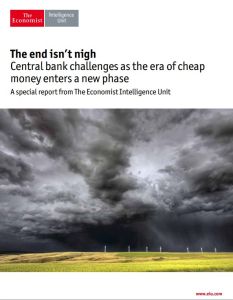Join getAbstract to access the summary!

Join getAbstract to access the summary!
The Economist Intelligence Unit
The End Isn't Nigh
Central Bank Challenges as the Era of Cheap Money Enters a New Phase
EIU, 2013
What's inside?
The imminent end to quantitative easing has put the markets in a tizzy. But is this panic premature?
Recommendation
When slashing interest rates failed to ignite a recovery in the aftermath of the global financial crisis, several developed nations resorted to quantitative easing. Central banks bought up assets, “funneling trillions of dollars of newly created money via commercial banks to the real economy.” As the world recovers, central banks inevitability will need to wean investors off cheap cash, but the mere idea creates market hysteria. getAbstract recommends this succinct assessment to policy makers, central bankers and skittish investors, who need not fear: “The end isn’t nigh.”
Summary
About the Author
The Economist Intelligence Unit is an independent research and analysis organization.




















































































































Comment on this summary